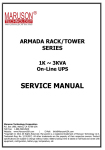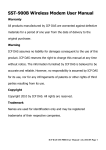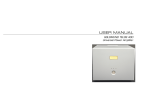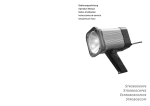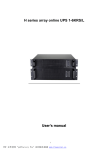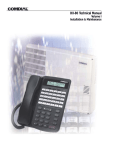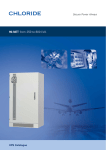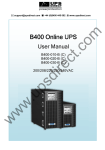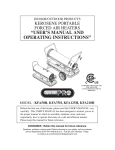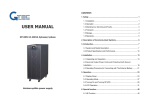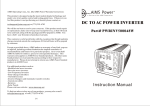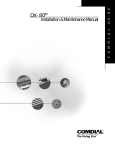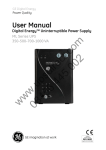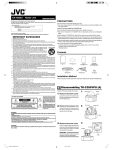Download USER MANUAL
Transcript
Перейти на сайт USER MANUAL RACK MOUNT 1/2/3/6kVA Table of Contents 1. Introduction ···························································································································1 2. Safety Instructions·················································································································2 3. System Description ··············································································································4 3.1 Display Panel············································································································4 3.2 Rear Panel················································································································5 4. Maintenance···························································································································7 4.1 Operation Environment···························································································7 4.2 Battery Application··································································································7 4.3 Troubleshooting······································································································ 7 5. Technical Data·······················································································································9 5.1 Electrical Specification···························································································· 9 5.2 Typical Stored Energy Time···················································································9 5.3 Mechanical Data·······································································································9 5.4 Standards Conformity·································································································10 5.5 Communication Port·····························································································10 5.5.1 RS232 Interface···························································································11 5.5.2 AS400 Interface ·························································································11 1. INTRODUCTION This series is an industry rack-mount design of an advanced true-online sinewave Uninterruptible Power System. It protects your systems by supplying battery backup when power fails.By using with WinPower software, the uninterruptible power system (UPS) will safely save current data and gracefully shut down the operating system before the battery is fully discharged. It provides perfect protection specifically for fileservers, minicomputers, Internet hubs, telecommunication systems and other mission-critical applications. It can auto restart while AC source restored after discharge shutdown and it also can support the automatically transfer or re-transfer to lnverter mode after the overload is cleared. This rack-mount series includes: C1KR(S), C2KR(S), C3KR(S), C6KR. The models with suffix”S” allow for extending runtime by simply plugging in additional battery packs. In this manual, hereafter, 1K(S) represents model C1KR(S), 2K(S) represents model C2KR(S), 3K(S) represents model C3KR(S), and 6K represents model C6KR. 1 2. SAFETY INSTRUCTIONS PLEASE READ THIS USER MANUAL AND THE SAFETY INSTRUCTIONS BEFORE INSTALLING THE UNIT AND STARTING IT UP! Transport ● Please transport the UPS system only in the original packaging (to protect against shock and impact). Set-up ● Condensation may occur if the UPS system is moved directly from a cold to a warm environment. The UPS system must be absolutely dry before being installed. Please allow an acclimatization time of at least two hours. ● Do not install the UPS system near water or in damp environment. ● Do not install the UPS system where it would be exposed to direct sunlight or near heat. ● Do not block air vents in the front, in the back or on the sides of the UPS. Installation ● Do not connect appliances or items of equipment which would overload the UPS system (e.g. laser printers) to the UPS outlet socket. ● Place cables in such a way that no one can step on or trip over them. ● Do not connect household appliances such as hair dryers to the UPS output sockets. ● The UPS can be operated by any individuals with no previous training. Following for 1K(S)/2K(S)/3K(S) only ● Connect the UPS system only to an earthed shockproof socket outlet. ● The utility power socket-outlet (shockproof socket-outlet) must be easily accessible and close to the UPS system. ● During the installation of this equipment it should be assured that the sum of the leakage current of the UPS and the connected loads does not exceed 3.5mA. Following for 6K only ● Warning - This is a product for designated sales distribution to authorized partners. Installation or additional measures should be carried out by qualitied personal to prevent disturbances. ● A readily accessible disconnection device shall be incorporated in the building installation wiring and the disconnection device must be easily accessible and close to the UPS system. ● Only qualified maintenance personnel may carry out installations. 2 2. SAFETY INSTRUCTIONS Operation ● The UPS system features its own, internal current source (batteries). The UPS output sockets may contain hazardous voltage through operation from the battery even if the UPS system is not connected to the utility power socket-outlet. ● In order to fully disconnect the UPS system, first press the Standby switch then disconnect the mains . ● Ensure that no fluids or other foreign objects can enter the UPS system. Maintenance, servicing and faults ● The UPS system operates with hazardous voltages. Repairs should be carried out only by qualified maintenance personnel. ● Caution - risk of electric shock. Even after the unit is disconnected from the mains power supply (utility power socket -outlet), components inside the UPS system are still connected to the battery and still present hazardous voltage. ● Before carrying out any kind of servicing and/or maintenance, disconnect the batteries and verify that no current is present and no hazardous voltage exists in the terminals of high capability capacitors such as BUS capacitors. ● The batteries can present a risk of high voltage and high current. Replacement or maintenance of the batteries should be carried out by qualitied service personnel who are knowledgeable about batteries. No other persons should handle the batteries. ● Caution - risk of electric shock. The battery circuit is not isolated from the input voltage. Hazardous voltages may occur between the battery terminals and the ground. Before touching, please verify that no hazardous voltage is present! ● Batteries may cause electric shock and have a high short-circuit current. Please take the precautionary measures specified below and any other measures necessary when working with batteries: - remove wristwatches, rings and other metal objects - use only tools with insulated grips and handles. ● W hen replacing the batteries, install the same number and the same type of the batteries. ● Do not incinerate batteries, they may explode. ● Do not open or mutilate batteries, released electrolyte is highly poisonous and harmful to the skin and eyes. ● Please replace the fuse only with a fuse of the same type and same amperage in order to avoid fire hazards. 3 3. SYSTEM DESCRIPTION 3.1 DISPLAY PANEL The power control and the operating indicators are located on the front panel of the UPS . ON-SWITCH INDICATOR 1 UPS ON LED INDICATOR 2 BATTERY LED INDICATOR 3 BYPASS LED INDICATOR 4 AC INPUT LED INDICATOR 5 ALARM LED STANDBY-SWITCH ON-SWITCH ● The UPS can be turned on by pressing ON-SWITCH button for 1 second. ● An acoustic alarm can be deactivated by pressing ON-SW ITCH button again in battery mode. ● To perform self-diagnosis, by Pressing ON-SW ITCH again in utility power mode. STANDBY-SWITCH ● The inverter can be turned off by pressing STANDBY-SWITCH. The output can be provided by the mains power via the BYPASS. AC INPUT LED ● Lights up when the mains power is available. ● Blinks and the BATTERY-LED lights up at the same time when the mains power is out of tolerance. ● Blinks when the input polarity of the live conductor(L) and the neutral conductor (N) of site wiring reversed. UPS ON LED ● Lights up when output power is supplied by the mains power via the inverter. BATTERY LED ● Lights up when the mains power fails and the inverter is powered by the batteries. BYPASS LED ● Lights up when output power is provided by the mains power via the bypass. ALARM LED ● Lights up when the UPS system is in fault condition, at the same time, the acoustic alarm beeps continuously or beeps every second according to the different fault conditions. 4 3. SYSTEM DESCRIPTION INDICATOR 1-5 ● Shows the load level in utility power mode. ● Shows the battery level in battery mode. load level INDICATOR 1 INDICATOR 2 INDICATOR 3 INDICATOR 4 96%-105% 76%-95% 56%-75% 36%-55% INDICATOR 5 1%-35% battery level 1%-35% 36%-55% 56%-75% 76%-95% 96%-100% 3.2 REAR PANEL The rear panels of the UPS and the battery packs are shown as below: Only available Input Output socket socket for 1KS Surge protection (RJ45) Intelligent slot Input breaker Communication port 1K(S) Input Intelligent slot socket Surge External Input breaker protection battery (RJ45) socket Output socket Communication port 2K 5 3. SYSTEM DESCRIPTION Input IntelligentOutput Output breaker Input Surge External Output battery fuse breaker Communication port 2KS/3K(S) Output Output socket fuse Intelligent slot Input breaker Input/ External battery output socket terminal Surge Communication protection port (RJ45) 6K Battery Pack for 1KS/2K(S)/3K(S) Battery Pack for 6K 6 3. SYSTEM DESCRIPTION Surge Protection(RJ45 Port): This is a transient voltage surge-suppressor for network or fax/modem protection. Communication Port: W inPower software can be used with the UPS for power management. Standard serial interface cable is compatible with 1K(S)/2K(S)/3K(S) UPS, however, only the special cable supplied with the UPS can be used on 6K UPS. Input/Output: If socket is available, just insert compatible cable plug. If terminal is available, qualified electrician should be required for wiring and installation. Note: Terminal cover should be put back for safety reason after wiring completed. Input Breaker: If the breaker is tripped, reduce the load connected to the UPS and reset the breaker. External Battery Socket: Dedicated battery power cable is supplied with the battery pack. Insert the cable into the external battery socket on the UPS and battery pack output socket separately to connect battery pack to the UPS. The same battery packs can be daisy chained together to achieve desired run time. Notes: It is suggested that one battery pack can be connected with one UPS main unit. Only the identical battery packs can be connected in parallel to the models with suffix “S” to extend the backup time .Please consult the distributor for further information. 4.1 OPERATION ENVIRONMENT Ambient Temperature: 0°C to 40°C Height of sea level < 1000m Relative humidity: <95% 4.2 BATTERY APPLICATION Simply connect the UPS to the mains to fully charge the batteries for 12 hours prior to use is recommended. It can also be used immediately without charging the batteries first but the backup time will be less than standard level. Under normal conditions, the battery life lasts 3 to 5 years. In case if the battery is found not in good condition, earlier replacement should be made. The replacement of the battery should be carried out by qualified service personnel . Please contact the distributor . The battery should be charged once every three months for at least 12 hours. In areas with higher temperatures, the battery should be charged once every two months and each charging period shall be at least 12 hours. 7 4.MAINTENANCE 4.3 TROUBLESHOOTING The troubleshooting chart covers most of the difficulties that you may encounter under normal working condition. Such information can be used to determine whether the fault is caused by external factors or how to tackle the problem. If the UPS still fails to operate properly, please contact the service centre as soon as possible . Be sure you have the following information when contacting the service personnel: 1. Model number, serial number 2. Date on which the problem occurred 3. Description in detail of the problem PROBLEM No indication, no audible alarm even though the UPS is connected to mains power supply No input voltage AC INPUT LED blinks Maybe reversed polarity (L/N) of site wiring. AC INPUT LED blinks and BATTERY LED lights up POSSIBLE CAUSE Input power and/or frequency are out of tolerance CORRECTIVE ACTION Check building wiring socketoutlet, input power cable, input breaker. Please check the polarity of site wiring or building wiring. The UPS is now running in battery mode.To save your data and then close the applications, ensure that mains power is within the input voltage/frequency range of the UPS AC INPUT and BYPASS LED light up even though the power supply is available Inverter not switched on Press On button “I” UPS ON LED lights up, warning sound at intervals of every 1 or 4 seconds Mains power supply has failed In battery mode operation; warning sound at intervals of 1 second means battery discharge near ending ALARM LED lights up, warning sound once a second Overloaded Reduce number of loads connected to the UPS ALARM-LED lights up, the alarm beeps continuously Maybe the UPS has internal faults Call for services Battery discharge time diminishes Batteries not fully charged / batteries aged/batteries defected Charge the batteries for at least 12 hours. Please consult the distributor or call for battery replacement 8 5. TECHNICAL DATA 5.1 ELECTRICAL SPECIFICATIONS Model INPUT Voltage Frequency Amperage (maximum) OUTPUT C1KR/ C1KRS Power rating C2KR/ C2KRS C3KR/C3KRS 220VAC 46 Hz ~ 54 Hz(Adjustable) 5A 10A/12A 15 A 30A 1kVA 0.7k W 2kVA 1.4kW 3kVA 2.1kW 6kVA 4.2kW Voltage Frequency 220VAC 50Hz±0.2Hz(Battery Mode) Wave form BATTERIES(STANDARD) Number and type 3x12V7.2Ah Nominal voltage C6KR 50 Hz( 1±0.1%) (Battery Mode) Sinusoidal 8x12V7.2Ah 36VDC 20x12V7.2Ah 96VDC 240VDC 5.2 T YPICAL BACKUP TIME (BATTERY MODE) Typical values at 25°C in minutes: M odel C 1K R C 2K R C 3K R C 6K R 100 % Load 5 9 5 8 50 % Load 14 21 15 23 Notes: Backup time of “S” models, please consult the distributor. 5.3 MECHANICAL DATA M odel C 1K R C 1K R S B a tte r y P a c k 36V D C C 2K R C 2K R S C 3K R C 3K R S B a tte r y P a c k 96V D C C 6K R B a tte r y P a c k 240VD C N e t W e ig h t (k g ) 1 6 .3 9 .1 D im e n tio n ( m m ) 2 2 .5 1 0 .3 11 .5 11 .2 1 2 .3 D e p th : 4 5 0 2 7 .8 1 8 .3 6 4 .2 D e p th : 6 0 0 9 5. TECHNICAL DATA 5.4 STANDARDS CONFORMITY 1K(S)/2K(S)/3K(S) Conducted Emission: EN50091-2 Class B Radiated Emission: EN50091-2 Class B Harmonic Current: EN61000-3-2 Voltage Fluctuations and Flicker: EN61000-3-3 EMS: EN61000-4-2(ESD) Level 4 EN61000-4-3(RS) Level 3 EN61000-4-4(EFT) Level 4 EN61000-4-5( Lighting Surge) Level 4 EN61000-2-2(Immunity to low frequency signals) 6K Conducted Emission: EN50091-2 Rated output current exceeding 25A limits Radiated Emission: EN50091-2 Rated output current exceeding 25A limits EMS: EN61000-4-2(ESD) Level 4 EN61000-4-3(RS) Level 3 EN61000-4-4(EFT) Level 4 EN61000-4-5(Lighting Surge) Level 4 EN61000-2-2(Immunity to low frequency signals) 5.5 COMMUNICATION PORT The UPS is equipped with a standard RS232 port to communicate with a host computer. The RS232 communication port transmits both utility power and UPS status to the host computer, providing the host computer with proprietary command sequence to monitor the utility power and the UPS status and to control the UPS through WinPower software. The data format of RS232 : Baud Rate : 2400 bps Data Length : 8 bits Ending Bit : 1 bit Parity Bit : none 10 5. TECHNICAL DATA 5.5.1 RS232 INTERFACE The following is the pin assignment and description of DB-9 connector. Pin# Description I/O 2 3 5 RS232 Tx RS232 Rx Ground Output Input Input TX RX GND 5.5.2 AS400 RS232 Interface INTERFACE Except for the communication protocol as mentioned above, this series UPS has an optional AS400 card for AS400 communication protocol. Please contact your local distributor for details. The following is the pin assignment and description of DB-9 connector in AS400 card. Pin# Description I/O type 1 2 3 4 5 6 7 8 9 UPS Failure Summary Alarm GND Remote shutdown Common Bypass Battery Low UPS ON Utility power failure(Line Loss) Output Output Input Output Output Output Output DB9 Interface of AS400 communication protocol 11













